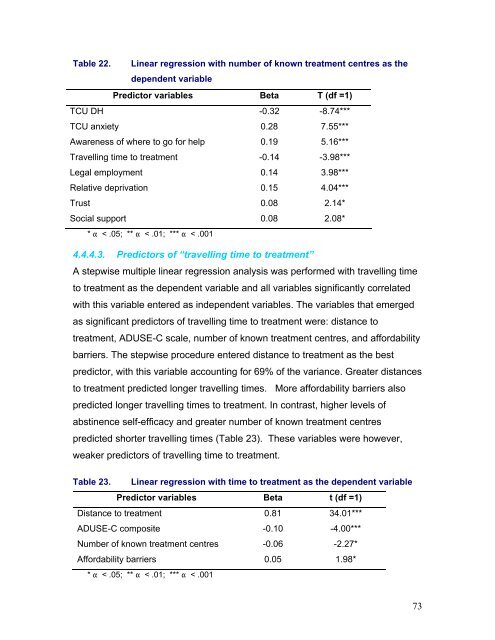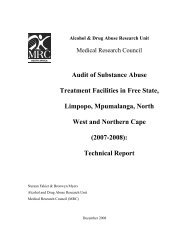Access to substance abuse treatment in the Cape Town metropole ...
Access to substance abuse treatment in the Cape Town metropole ...
Access to substance abuse treatment in the Cape Town metropole ...
You also want an ePaper? Increase the reach of your titles
YUMPU automatically turns print PDFs into web optimized ePapers that Google loves.
Table 22. L<strong>in</strong>ear regression with number of known <strong>treatment</strong> centres as <strong>the</strong>dependent variablePredic<strong>to</strong>r variables Beta T (df =1)TCU DH -0.32 -8.74***TCU anxiety 0.28 7.55***Awareness of where <strong>to</strong> go for help 0.19 5.16***Travell<strong>in</strong>g time <strong>to</strong> <strong>treatment</strong> -0.14 -3.98***Legal employment 0.14 3.98***Relative deprivation 0.15 4.04***Trust 0.08 2.14*Social support 0.08 2.08** " < .05; ** " < .01; *** " < .0014.4.4.3. Predic<strong>to</strong>rs of “travell<strong>in</strong>g time <strong>to</strong> <strong>treatment</strong>”A stepwise multiple l<strong>in</strong>ear regression analysis was performed with travell<strong>in</strong>g time<strong>to</strong> <strong>treatment</strong> as <strong>the</strong> dependent variable and all variables significantly correlatedwith this variable entered as <strong>in</strong>dependent variables. The variables that emergedas significant predic<strong>to</strong>rs of travell<strong>in</strong>g time <strong>to</strong> <strong>treatment</strong> were: distance <strong>to</strong><strong>treatment</strong>, ADUSE-C scale, number of known <strong>treatment</strong> centres, and affordabilitybarriers. The stepwise procedure entered distance <strong>to</strong> <strong>treatment</strong> as <strong>the</strong> bestpredic<strong>to</strong>r, with this variable account<strong>in</strong>g for 69% of <strong>the</strong> variance. Greater distances<strong>to</strong> <strong>treatment</strong> predicted longer travell<strong>in</strong>g times. More affordability barriers alsopredicted longer travell<strong>in</strong>g times <strong>to</strong> <strong>treatment</strong>. In contrast, higher levels ofabst<strong>in</strong>ence self-efficacy and greater number of known <strong>treatment</strong> centrespredicted shorter travell<strong>in</strong>g times (Table 23). These variables were however,weaker predic<strong>to</strong>rs of travell<strong>in</strong>g time <strong>to</strong> <strong>treatment</strong>.Table 23. L<strong>in</strong>ear regression with time <strong>to</strong> <strong>treatment</strong> as <strong>the</strong> dependent variablePredic<strong>to</strong>r variables Beta t (df =1)Distance <strong>to</strong> <strong>treatment</strong> 0.81 34.01***ADUSE-C composite -0.10 -4.00***Number of known <strong>treatment</strong> centres -0.06 -2.27*Affordability barriers 0.05 1.98** " < .05; ** " < .01; *** " < .00173
















